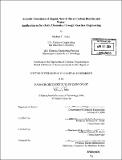Acoustic emulsions of liquid, near-critical carbon dioxide and water : application to synthetic chemistry through reaction engineering
Author(s)
Timko, Michael T., 1974-
DownloadFull printable version (17.20Mb)
Other Contributors
Massachusetts Institute of Technology. Dept. of Chemical Engineering.
Advisor
Jefferson W. Tester and Kenneth A. Smith.
Terms of use
Metadata
Show full item recordAbstract
Supervised by The need to eliminate hazardous solvents, such as methanol, toluene, and dichloromethane, in specialty and pharmaceutical chemical synthesis applications has motivated the development of alternative approaches. Because of its environmental compatibility, low cost, and favorable physicochemical properties, supercritical carbon dioxide (scCO2) has been actively considered to replace conventional hydrocarbon solvents. Progress towards this objective has been impressive, for example scCO2 is used as a selective extraction solvent in several commercial processes. By comparison, development of scCO2 as a reaction solvent has been much less successful due to its limited solvation power. Furthermore, the rates of reactions conducted in scCO2 tend to be slower than and their selectivities are comparable to those observed in hydrocarbon solvents. This research focused on development of water/carbon dioxide biphasic reaction systems as an engineering solution to increase reaction rates and manipulate selectivity while preserving environmental compatibility of scCO2. Emulsification by power ultrasound was selected as an additive-free means to bring near-critical liquid carbon dioxide and water into intimate contact and increase interphase transport. With this approach, the complementary solvation powers of the two solvents could be utilized to expand the range of potential chemical transformations. Carbon dioxide was envisioned as a delivery solvent, allowing access to the unique abilities of water to accelerate organic reactions while influencing their product spectrum. First, the partitioning behavior of organic solutes was investigated with the objective of developing empirical correlations for estimating partition coefficients. (cont.) The available literature database was limited primarily to substituted phenols. This study nearly doubled the number of compounds for which carbon dioxide/water partition coefficient data are known to include a wider range of aromatic, aliphatic, and heterocyclic compounds. Several existing correlation methods, including a comparison to water solubility, estimation using octanol/water partition coefficients, and estimation using linear solvation energy relationships, were used. Good correlations were found using water solubility and octanol/water partition coefficients (0.4 log1o mole fraction units), provided that compounds with hydrogen bond donating ability were excluded from the analysis. A linear solvation energy relationship with optimized coefficients was found to accurately predict partition coefficients within ±0.2 log1o mole fraction units and was not limited to compounds that lack hydrogen bond donating ability. In general, such correlations should be useful for screening chemical reactions and for developing reactor designs. Power ultrasound at a frequency of 20 kHz was used to generate emulsions containing liquid, near-critical carbon dioxide and water. Since no surfactants were used, sonication simultaneously generated emulsions with water and carbon dioxide continuous phases. Visual observation and turbidity measurements indicated that all types of emulsions broke spontaneously within 30 minutes. The short lifetimes of these surfactant-free emulsions is expected ...
Description
Thesis (Ph. D.)--Massachusetts Institute of Technology, Dept. of Chemical Engineering, 2004. Includes bibliographical references.
Date issued
2004Department
Massachusetts Institute of Technology. Department of Chemical EngineeringPublisher
Massachusetts Institute of Technology
Keywords
Chemical Engineering.